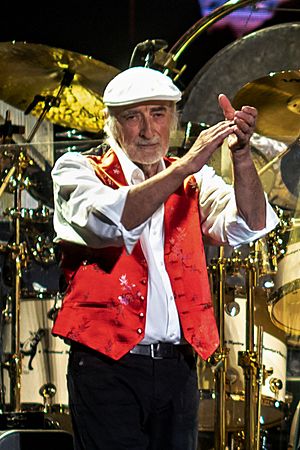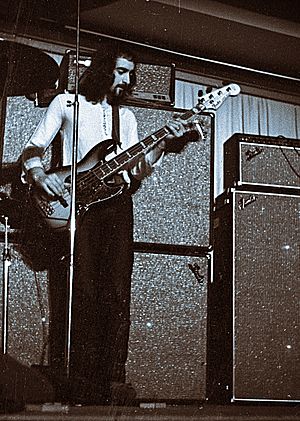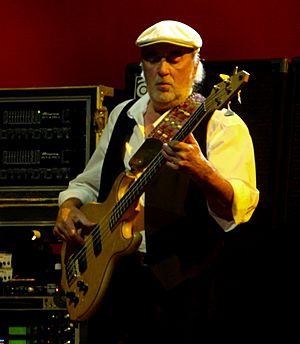John McVie facts for kids
Quick facts for kids
John McVie
|
|
|---|---|

McVie in 2018
|
|
| Background information | |
| Birth name | John Graham McVie |
| Born | 26 November 1945 Ealing, Middlesex, England |
| Genres | |
| Occupation(s) | Musician |
| Instruments | Bass guitar |
| Years active | 1963–present |
| Labels |
|
John Graham McVie (born 26 November 1945) is a British bass guitarist. He is famous for being a member of the rock band Fleetwood Mac since 1967. Before that, he played with John Mayall & the Bluesbreakers from 1964 to 1967. The name of Fleetwood Mac comes from his last name and the last name of drummer Mick Fleetwood.
John McVie joined Fleetwood Mac soon after it started in 1967. He replaced a temporary bass player. John McVie and Mick Fleetwood are the only two members who have played on every Fleetwood Mac album. They have been with the band for over fifty years.
In 1968, McVie married blues pianist and singer Christine Perfect. She later joined Fleetwood Mac two years later. John and Christine McVie divorced in 1976. However, they continued to work together in the band. During this time, the band recorded the album Rumours. This album was a huge success. Its title hinted at the stories about the band members' lives.
McVie was welcomed into the Rock and Roll Hall of Fame in 1998. This was for his work as a member of Fleetwood Mac.
Early Life and Music
John Graham McVie was born on November 26, 1945. His birthplace was Ealing, in west London. He went to Walpole Grammar School. John started playing the trumpet when he was young. At age 14, he began playing guitar in local bands. He often played songs by the Shadows.
John soon noticed his friends were learning lead guitar. So, he decided to play the bass guitar instead. At first, he took off the top two strings from his guitar. This helped him play the bass parts. Later, his father bought him a pink Fender bass guitar. This was like the one used by Jet Harris, a bass player he admired.
After leaving school at 17, McVie trained for nine months. He learned to be a tax inspector. This happened at the same time his music career began.
First Bands
John McVie's first musical experience was with friends. They played in a house in Ealing. His first job as a bass player was in a band called the Krewsaders. This band was formed by boys who lived on the same street as John. The Krewsaders mostly played at weddings and parties. They covered songs by the Shadows.
Rolling Stone magazine listed McVie as number 37. This was on their list of the fifty greatest bassists of all time.
Career Highlights
Joining John Mayall's Bluesbreakers
Around the time John McVie was a tax inspector, John Mayall was forming a blues band. This band was called John Mayall and the Bluesbreakers. Mayall wanted a different bass player at first. But that player suggested McVie. Mayall contacted John and asked him to try out for the band.
McVie got an offer to play bass in the Bluesbreakers. He accepted, but kept his day job for nine more months. Then he became a full-time musician. John Mayall taught McVie a lot about music. McVie learned to play the blues by listening to records. These records were by artists like B.B. King and Willie Dixon. McVie was the band's bassist for four and a half years. He was sometimes fired and then hired back.
Forming Fleetwood Mac
In 1966, Peter Green joined the Bluesbreakers. He became the new lead guitar player. Later, Mick Fleetwood became the drummer. Green, McVie, and Fleetwood became good friends. John Mayall gave Green some free studio time. Green asked McVie and Fleetwood to record with him. They recorded three songs together. One song was an instrumental called "Fleetwood Mac."
Later that year, Green decided to form his own band. He named it "Fleetwood Mac" after Fleetwood and McVie. Mick Fleetwood joined right away. However, McVie was not sure at first. He liked the steady job with the Bluesbreakers. So, Green hired a temporary bassist. A few weeks later, McVie changed his mind. He felt the Bluesbreakers were playing too much jazz. He joined Fleetwood Mac in September 1967.
Success with Fleetwood Mac
With McVie in Fleetwood Mac, the band recorded its first album. It was also called Fleetwood Mac. The album came out in February 1968. It quickly became a hit in England. This made Fleetwood Mac a big part of the English blues music scene. The band started playing live shows in clubs and pubs. They became well-known in the country. Over the next three years, they had many hit songs in the UK. They also became popular in Europe.
Christine Perfect Joins the Band
While on tour, Fleetwood Mac often played with another blues band. This band was called Chicken Shack. At one of these shows, McVie met Christine Perfect. She was the lead singer and piano player for Chicken Shack. They had a quick romance and married after only two weeks. Peter Green was the best man at their wedding.
John and Christine could not spend much time together. This was because their bands were always touring. So, Christine (now McVie) left Chicken Shack. She wanted to spend more time with John. In 1970, Peter Green left Fleetwood Mac. McVie then convinced Christine to join him in Fleetwood Mac.
International Fame
After 1970, Fleetwood Mac had many different band members. This sometimes caused problems within the group. Also, constant touring and John's heavy drinking put a strain on his marriage to Christine. In 1974, the McVies and other band members moved to Los Angeles.
In 1975, Fleetwood Mac became famous worldwide. This happened after Stevie Nicks and Lindsey Buckingham joined the band. With the band's success came big problems for the McVies' marriage. In 1976, while recording the album Rumours, John and Christine McVie divorced. Several of Christine's songs on this album were about John. One famous song was "Don't Stop". John McVie suggested the title Rumours. He felt the songs were like journal entries about each other.
In 1981, McVie went on tour again with the Bluesbreakers. This was a reunion tour. In 1989, McVie's wife Julie Ann had their daughter, Molly Elizabeth McVie. John McVie enjoys sailing in his free time.
In October 2013, McVie was diagnosed with colon cancer. He started treatment for it. He continued to play with the band during their 2014 tour. This was after his condition improved. In 2017, it was reported that McVie's colon cancer was completely gone.
Discography
With Fleetwood Mac
| Year | Album | US | UK | Additional information |
|---|---|---|---|---|
| 1968 | Fleetwood Mac | 198 | 4 | Plays bass on all tracks except "Long Grey Mare" |
| 1968 | Mr. Wonderful | - | 10 | - |
| 1969 | Then Play On | 192 | 6 | credited for the instrumental "Searching For Madge" |
| 1970 | Kiln House | 69 | 39 | co-wrote "Station Man" and "Jewel Eyed Judy" |
| 1971 | Future Games | 91 | - | - |
| 1972 | Bare Trees | 70 | - | The cover photo was taken by McVie |
| 1973 | Penguin | 49 | - | Plays bass on all tracks except "Revelation" and "The Derelict" |
| 1973 | Mystery to Me | 68 | - | co-wrote "Forever" |
| 1974 | Heroes Are Hard to Find | 34 | - | - |
| 1975 | Fleetwood Mac | 1 | 23 | Appears on album cover with Mick Fleetwood |
| 1977 | Rumours | 1 | 1 | Co-Wrote "The Chain" |
| 1979 | Tusk | 4 | 1 | – |
| 1980 | Live | 14 | 31 | - |
| 1982 | Mirage | 1 | 5 | Backing vocals on Gypsy B-Side "Cool Water" |
| 1987 | Tango in the Night | 7 | 1 | - |
| 1988 | Greatest Hits | 14 | 3 | - |
| 1990 | Behind the Mask | 18 | 1 | - |
| 1995 | Time | - | 47 | - |
| 1997 | The Dance | 1 | 15 | featured on background vocals on "Say You Love Me" |
| 2003 | Say You Will | 3 | 6 |
With John Mayall's Bluesbreakers
| Year | Album | US | UK | Additional information |
|---|---|---|---|---|
| 1965 | John Mayall Plays John Mayall | - | - | Live at Klooks Kleek |
| 1966 | Blues Breakers with Eric Clapton | - | 6 | - |
| 1967 | A Hard Road | - | 10 | - |
| 1967 | Crusade | - | 8 | - |
Solo Albums
| Year | Album | US | UK | Additional information |
|---|---|---|---|---|
| 1992 | John McVie's "Gotta Band" with Lola Thomas | - | - | - |
With Lindsey Buckingham and Christine McVie
| Year | Album | U.S. Billboard 200 | UK Albums Chart |
|---|---|---|---|
| 2017 | Lindsey Buckingham/Christine McVie | 17 | 5 |
Songwriting for Fleetwood Mac
| Year | Song | Netherlands Singles Chart | U.S. Mainstream Rock |
|---|---|---|---|
| 1969 | "Searching For Madge" (John McVie) |
|
|
| 1970 (1985) | "On We Jam" (McVie, Jeremy Spencer, Danny Kirwan, Peter Green, Mick Fleetwood) |
|
|
| 1970 | "Station Man" (McVie, Spencer, Kirwan) |
|
|
| 1970 | "Jewel Eyed Judy" (McVie, Fleetwood, Kirwan) |
|
|
| 1971 | "The Purple Dancer" (McVie, Kirwan, Fleetwood) |
|
|
| 1971 | "What A Shame" (McVie, Fleetwood, Kirwan, Christine McVie, Bob Welch) |
|
|
| 1973 | "Forever" (McVie, Bob Weston, Welch) |
|
|
| 1975 (2004) | "Jam No.2" (McVie, Fleetwood, C. McVie, Lindsey Buckingham) |
|
|
| 1977 | "The Chain" (McVie, Fleetwood, Buckingham, Stevie Nicks, C. McVie) |
|
|
| 1977 (2004) | "For Duster (The Blues)" (McVie, Fleetwood, Buckingham, C. McVie) |
|
|
See also
 In Spanish: John McVie para niños
In Spanish: John McVie para niños



